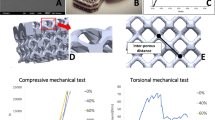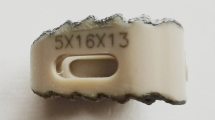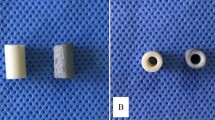Abstract
Cervical degenerative disease is a common and frequently occurring disease, which seriously affects the health and quality of the life of patients worldwide. Anterior cervical decompression and interbody fusion is currently recognized as the gold standard for the treatment of degenerative cervical spondylosis. Polyetheretherketone (PEEK) has become the prevailing material for cervical fusion surgery. Although PEEK has excellent biocompatibility, it is difficult to form bone connection at its bone-implant interface due to its low surface hydrophilicity and conductivity. It is widely accepted that Ti has excellent osteogenic activity and biocompatibility. In this study, a Ti-PEEK composite cage was prepared by coating Ti on the surface of a PEEK cage using a vacuum plasma spraying technique to enhance the osteogenic property of PEEK. The Ti-PEEK samples were evaluated in terms of their in vitro cellular behaviors and in vivo osteointegration, and the results were compared to a pure PEEK substrate. The skeleton staining and MTS assay indicated that the MC3T3-E1 cells spread and grew well on the surface of Ti-PEEK cages. The osteogenic gene expression and western blot analysis of osteogenic protein showed upregulated bone-forming activity of MC3T3-E1 cells in Ti-PEEK cages. Furthermore, a significant increase in new bone formation was demonstrated on Ti-PEEK implants in comparison with PEEK implants at 12 weeks in a sheep cervical spine fusion test. These results proved that the Ti-PEEK cage exhibited enhanced osseointegrative properties compared to the PEEK cage both in vitro and in vivo.





taken from the PEEK group as the red allow showed. Scale bars: Scale bars: a-b,e–f,i-j 2 mm; c-d,g-h,k-l 1 mm

Similar content being viewed by others
References
K. Anselme, B. Noe¨l, P. Hardouin, Human osteoblast adhesion on titanium alloy, stainless steel, glass and plastic substrates with same surface topography. J. Mater. Sci. Mater. Med. 10(12), 815–819 (1999)
S. Belouettar, A. Abbadi, Z. Azari et al., Experimental investigation of static and fatigue behaviour of composites honeycomb materials using four point bending tests. Compos. Struct. 87(3), 265–273 (2009)
N. Bertollo, R. Da Assuncao, N.J. Hancock et al., Influence of electron beam melting manufactured implants on ingrowth and shear strength in an ovine model. J. Arthroplasty 27(8), 1429–1436 (2012)
H. Bodén, M. Salemyr, O. Sköldenberg et al., Total hip arthroplasty with an uncemented hydroxyapatite-coated tapered titanium stem: results at a minimum of 10 years’ follow-up in 104 hips. J. Orthop. Sci. 11(2), 175–179 (2006)
B.D. Boyan, R. Batzer, K. Kieswetter et al., Titanium surface roughness alters responsiveness of MG63 osteoblast-like cells to 1α,25-(OH)2D3. J. Biomed. Mater. Res., Part A 39(1), 77–85 (2015)
G.R. Buttermann, Anterior cervical discectomy and fusion outcomes over 10 years. Spine 43(3), 207–214 (2018)
C. Castellani, R.A. Lindtner, P. Hausbrandt et al., Bone–implant interface strength and osseointegration: Biodegradable magnesium alloy versus standard titanium control. Acta Biomater. 7(1), 432–440 (2011)
B.C. Cheng, S. Koduri, C.A. Wing et al., Porous titanium-coated polyetheretherketone implants exhibit an improved bone–implant interface: an in vitro and in vivo biochemical, biomechanical, and histological study. Medical Devices (Auckland, NZ) 11, 391 (2018)
D.M. Devine, J. Hahn, R.G. Richards et al., Coating of carbon fiber-reinforced polyetheretherketone implants with titanium to improve bone apposition. J. Biomed. Mater. Res. B Appl. Biomater. 101(4), 591–598 (2013)
M. van Dijk, T.H. Smit, S. Sugihara et al., The effect of cage stiffness on the rate of lumbar interbody fusion: an in vivo model using poly (l-lactic Acid) and titanium cages. Spine 27(7), 682–688 (2002)
D. Duraccio, F. Mussano, M.G. Faga, Biomaterials for dental implants: current and future trends. J. Mater. Sci. 50(14), 4779–4812 (2015)
S. Fujibayashi, M. Takemoto, M. Neo et al., A novel synthetic material for spinal fusion: a prospective clinical trial of porous bioactive titanium metal for lumbar interbody fusion. Eur. Spine J. 20(9), 1486–1495 (2011)
K.Y. Ha, J.H. Shin, K.W. Kim et al., The fate of anterior autogenous bone graft after anterior radical surgery with or without posterior instrumentation in the treatment of pyogenic lumbar spondylodiscitis. Spine 32(17), 1856–1864 (2007)
C.M. Han, E.J. Lee, H.E. Kim et al., The electron beam deposition of titanium on polyetheretherketone (PEEK) and the resulting enhanced biological properties. Biomaterials 31(13), 3465–3470 (2010)
E.K. Hansson, T.H. Hansson, The costs for persons sick-listed more than one month because of low back or neck problems. A two-year prospective study of Swedish patients. Eur. Spine J. 14(4), 337–345 (2005)
A. Hermansen, R. Hedlund, L. Vavruch et al., A comparison between the carbon fiber cage and the cloward procedure in cervical spine surgery: a ten-to thirteen-year follow-up of a prospective randomized study. Spine 36(12), 919–925 (2011)
P. Korovessis, T. Repantis, V. Vitsas et al., Cervical spondylodiscitis associated with oesophageal perforation: a rare complication after anterior cervical fusion. Eur. J. Orthop. Surg. Traumatol. 23(2), 159–163 (2013)
S.M. Kurtz, J.N. Devine, PEEK biomaterials in trauma, orthopedic, and spinal implants. Biomaterials 28(32), 4845–4869 (2007)
S.D. Kuslich, C.L. Ulstrom, S.L. Griffith et al., The Bagby and Kuslich method of lumbar interbody fusion: history, techniques, and 2-year follow-up results of a United States prospective, multicenter trial. Spine 23(11), 1267–1278 (1998)
R. Ma, T. Tang, Current Strategies to Improve the Bioactivity of PEEK. Int. J. Mol. Sci. 15(4), 5426–5445 (2014)
A. Nouri, L. Tetreault, A. Singh et al., Degenerative cervical myelopathy: epidemiology, genetics, and pathogenesis. Spine 40(12), E675–E693 (2015)
M.H. Pelletier, N. Cordaro, V.M. Punjabi et al., PEEK Versus Ti Interbody Fusion Devices: Resultant Fusion, Bone Apposition, Initial and 26-Week Biomechanics. Clinic. Spine. Surg. 29(4), E208 (2016)
A.L. Rosa, M.M. Beloti, Effect of cpTi surface roughness on human bone marrow cell attachment, proliferation, and differentiation. Braz. Dent. J. 14(1), 16–21 (2003)
A.J. Schoenfeld, A.A. George, J.O. Bader et al., Incidence and epidemiology of cervical radiculopathy in the United States military: 2000 to 2009. J. Spinal. Disord. Tech. 25(1), 17 (2012)
M.L.R. Schwarz, M. Kowarsch, S. Rose et al., Effect of surface roughness, porosity, and a resorbable calcium phosphate coating on osseointegration of titanium in a minipig model. J. Biomed. Mater. Res., Part A 89A(3), 667–678 (2010)
Y.C. Shin, K.M. Pang, D.W. Han et al., Enhanced osteogenic differentiation of human mesenchymal stem cells on Ti surfaces with electrochemical nanopattern formation. Mater. Sci. Eng., C 99, 1174–1181 (2019)
G.S. Stein, J.B. Lian, T.A. Owen, Relationship of cell growth to the regulation of tissue-specific gene expression during osteoblast differentiation. FASEB J. 4(13), 3111–3123 (1990)
F. Tan, M. Naciri, D. Dowling et al., In vitro and in vivo bioactivity of CoBlast hydroxyapatite coating and the effect of impaction on its osteoconductivity. Biotechnol. Adv. 30(1), 352–362 (2012)
J.M. Toth, M. Wang, B.T. Estes et al., Polyetheretherketone as a biomaterial for spinal applications. Biomaterials 27(3), 324–334 (2006)
W.R. Walsh, N. Bertollo, C. Christou et al., Plasma-sprayed titanium coating to polyetheretherketone improves the bone-implant interface. The Spine Journal 15(5), 1041–1049 (2015)
A. Wennerberg, T. Albrektsson, Effects of titanium surface topography on bone integration: a systematic review. Clin. Oral Implant Res. 20, 172–184 (2009)
B. Wiedenhöfer, J. Nacke, M. Stephan et al., Is Total Disk Replacement a Cost-effective Treatment for Cervical Degenerative Disk Disease? Clin. Spine Surg. 30(5), E530–E534 (2017)
G.M. Wu, W.D. Hsiao, S.F. Kung, Investigation of hydroxyapatite coated polyether ether ketone composites by gas plasma sprays. Surf. Coat. Technol. 203(17), 2755–2758 (2009)
J.J. Yang, C.H. Yu, B.S. Chang et al., Subsidence and nonunion after anterior cervical interbody fusion using a stand-alone polyetheretherketone (PEEK) cage. Clin. Orthop. Surg. 3(1), 16–23 (2011)
C. Yao, D. Storey, T.J. Webster, Nanostructured metal coatings on polymers increase osteoblast attachment. Int. J. Nanomed. 2(3), 487–492 (2007)
C. Zhu, M. He, L. Mao et al., Titanium-interlayer mediated hydroxyapatite coating on polyetheretherketone: a prospective study in patients with single-level cervical degenerative disc disease. J. Transl. Med. 19(1), (2021)
Acknowledgment
The study was supported by the National Nature Science Foundation of China (81572185, 81702158); National Nature Science Foundation of Anhui Province (1708085MH185, 1708085QH205, 1808185QH275); Foreign Science and Technology Cooperation of Anhui Province (1704e1002229, 202004b11020027); Funding of “Peak” Training Program for Scientific Research of Yijishan Hospital, Wannan Medical College (GF2019T02, GF2019G07, GF2019G12).
Author information
Authors and Affiliations
Corresponding authors
Ethics declarations
Conflicts of interest
The authors declare no conflicts of interest.
Additional information
Publisher's Note
Springer Nature remains neutral with regard to jurisdictional claims in published maps and institutional affiliations.
Supplementary Information
Below is the link to the electronic supplementary material.
Rights and permissions
About this article
Cite this article
Liu, C., Zhang, Y., Xiao, L. et al. Vacuum plasma sprayed porous titanium coating on polyetheretherketone for ACDF improves the osteogenic ability: An in vitro and in vivo study. Biomed Microdevices 23, 21 (2021). https://doi.org/10.1007/s10544-021-00559-y
Accepted:
Published:
DOI: https://doi.org/10.1007/s10544-021-00559-y




